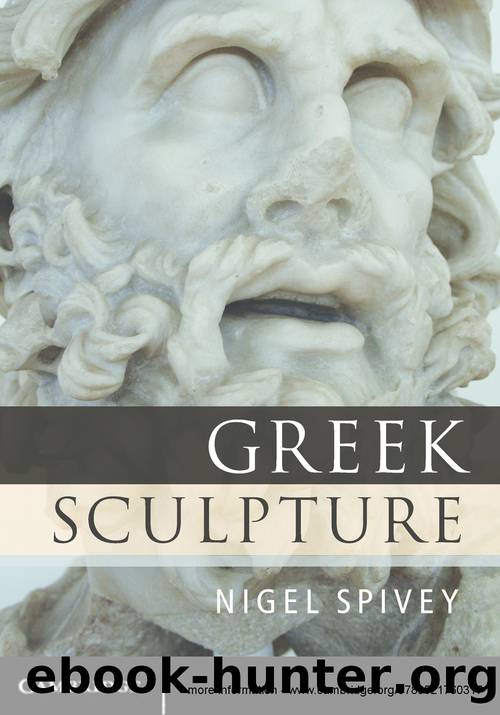Greek Sculpture by Nigel Spivey & Nigel Spivey

Author:Nigel Spivey & Nigel Spivey [Spivey]
Language: eng
Format: epub
Publisher: Cambridge University Press
Published: 2013-02-10T16:00:00+00:00
Figure 6.3 and Plate V Part of a limestone pediment from a temple on the Akropolis, c. 550 BC, showing Herakles against Triton. Ht 75 cm.
Figure 6.4 The Bluebeard Group, probably from the same pediment. Length approx. 3.25 m. As well as snake tails, the creature also has wings.
To shrug one's shoulders and merely allow this monster to be of ‘Oriental’ origin is an inadequate response. Some think it to be Nereus, the marine deity with powers to change his shape. It seems not to be hostile, with the leading member of the threesome holding up an arm in greeting (to a presumed figure of Herakles). But what if it has an allegorical purpose? Herodotus tells us (1.59) that Peisistratos established a power-base for his tyranny by uniting three factions in Attica: the ‘People of the Shore’, the ‘People of the Hills’ and the ‘People of the Plain’. Could it be that this smiling ‘tricorpor’ is an embodiment of those three factions – symbolized by a wave, a bird, and a wheatsheaf respectively?
No ancient source explicitly informs us that Peisistratos used Herakles as a mythical alter ego. We are told, however, that he employed bodyguards who carried, in Heraklean style, wooden clubs; and Herodotus has a story (1.60) of how Peisistratos once staged a melodramatic entry into Athens by finding a girl who was almost 1.8 m. tall, dressing her up like the armed Athena and driving towards the city in a chariot with her – preceded by heralds announcing that Athena herself was escorting Peisistratos to the Akropolis. A charade it might have been; but it points nevertheless to a politician aware of the potency of claiming divine or heroic affiliation (the Peisistratid family tree was proudly rooted with Homer's Nestor, ruler of Pylos).
Recurring themes on sixth-century Athenian painted pottery have been claimed as further proof of Peisistratid favour for Herakles. There was of course one important element in the Herakles story that made the hero particularly attractive as a model: with the aid of his divine protectress Athena, he is ultimately assumed as one of the Olympians. So any ruler who took on the role of being a ‘second Herakles’ – and we know that this was done by Alexander the Great (see p. 258), and several Roman emperors, not to mention a number of monarchs in Europe's ancien régime – could avoid possible accusations of impiety by claiming to be only Herakles the mortal, tirelessly striving to win divine favour.
Peisistratos and sons (Hipparchos succeeded in 527), sustaining this conceit, included in their aggrandizement of the Akropolis a pediment probably representing the Apotheosis of Herakles (Fig 6.5). The scene is sympathetically presented. A relatively enormous Zeus is enthroned near the centre of the pediment; his wife, Hera, responsible for the woes of Herakles since his infancy, stands by, as if at last placated. Next to her, we suppose, was Athena, who must introduce her protégé. Then comes Herakles, marked by the lionskin drawn up over his head. His eyes are directed to Zeus: a filial rapport has finally been made.
Download
This site does not store any files on its server. We only index and link to content provided by other sites. Please contact the content providers to delete copyright contents if any and email us, we'll remove relevant links or contents immediately.
Labyrinths(421)
Rick Steves Rome 2019 by Rick Steves & Gene Openshaw(315)
PICASSO (Unabridged) by Gertrude Stein(273)
Enid Yandell by Juilee Decker(185)
Greek Sculpture by Nigel Spivey & Nigel Spivey(184)
Aratra Pentelici, Seven Lectures on the Elements of Sculpture by John Ruskin(169)
The Toaster Project by Thomas Thwaites(166)
